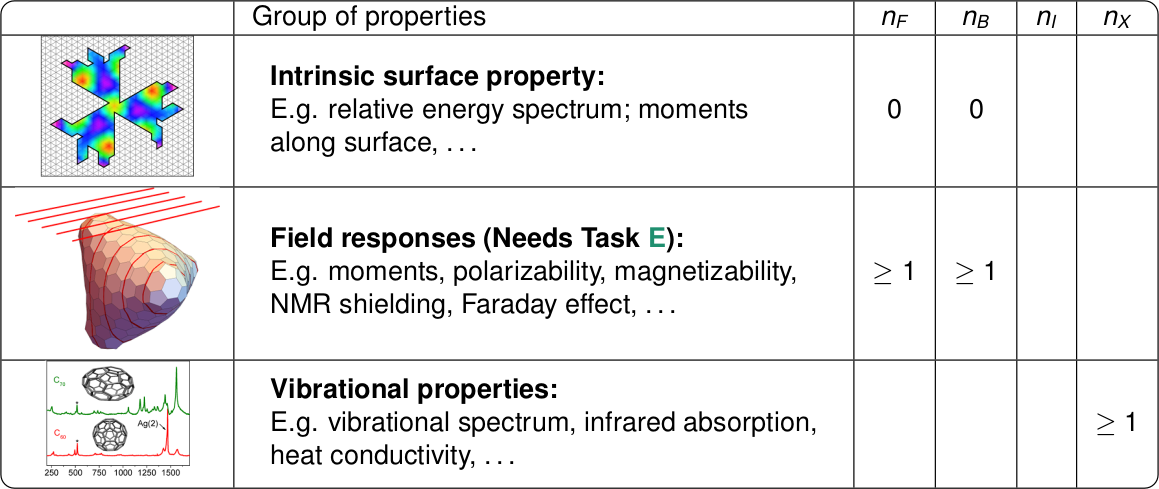
The goal of this task is to systematically study which useful molecular properties can be efficiently computed within the \acronym{} approximation framework. This will be investigated in collaboration with both P. Schwerdtfeger in Auckland, New Zealand (expert in computational quantum theory and in fullerene chemistry), and with local collaborator K.V. Mikkelsen (UCPH), expert in molecular property calculations.
Calculated approximations will be compared with high-quality quantum chemistry calculations for a benchmark suite of selected fullerenes and assessed for feasibility.
Most molecular properties can be computed as energy or wavefunction responses to perturbations: In particular, a large class of properties are energy-derivatives of the form \[ Property \propto \frac {\partial^{n_F+n_B+n_I+n_R} E} {\partial \mathbf{F}^{n_F} \partial \mathbf{B}^{n_B} \partial \mathbf{I}^{n_I} \partial \mathbf{R}^{n_R} } \] for electric field $\mathbf{F}$, magnetic field $\mathbf{B}$, nuclear spin $\mathbf{I}$, and molecular geometry $\mathbf{R}$. Details of how to compute molecular properties can be found, for example, in Jensen 2006, Chapter 10. In practice, linear or nonlinear response theory is used for actual calculations (see e.g. Olsen and Jørgensen 1985,Helgaker et al. 2002,Olsen et al. 2017). We can compute approximations to this entire class of properties, but care must be taken to make calculation efficient and the approximation useful.

The output of our methods developed in Task W is in the form of an electron density or approximate wavefunction defined on the manifold surface, and an approximate relative energy spectrum. Properties involving $\mathbf{F}$ and $\mathbf{B}$ (moments, polarizability, magnetizability, optical rotation, NMR shielding, etc.), require an approximate embedding in space. From Task E, we obtain a coarse geometry in miliseconds, and near-physical geometries in seconds. The fields $\mathbf{F}$ and $\mathbf{B}$ can be projected on the (coarse or refined) geometry to obtain their effect as potentials on the manifold surface, after which calculations in the intrinsic surface regime can proceed.
For properties involving geometry derivatives (vibrational spectrum, infrared absorption, thermal conductivity, etc.), we wish to avoid the high dimensionality of usual methods: computing a $3n\times 3n$ Hessian is feasible for small fullerenes ($\sim C_{20}-C_{200}$) and isomer spaces up to a few thousand structures, but for screening millions of structures, coarser approximation is needed. A multi-resolution approach that separates vibration into coarse and fine-grained components is under development. Coarse-grained vibration may be adequate for a number of properties including heat conductivity (approximated analogously to electrical conductivity with phonons and the Hessian replacing electrons and Hamiltonian in the transport equations).